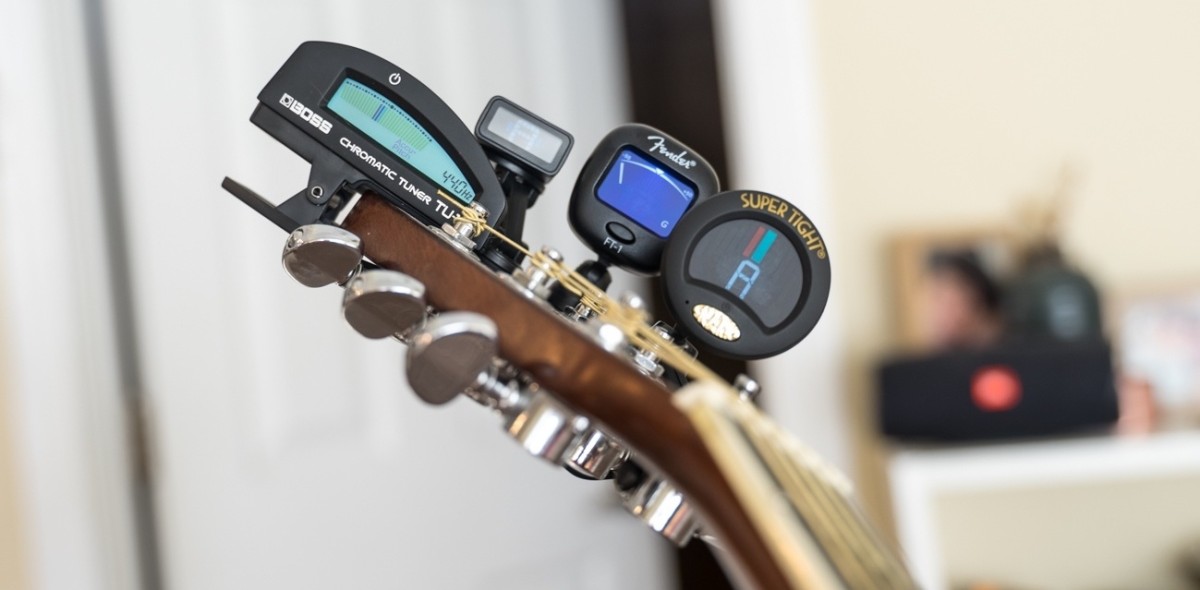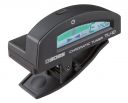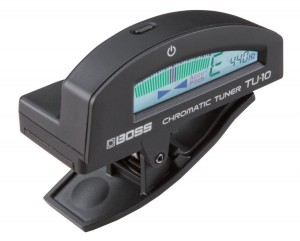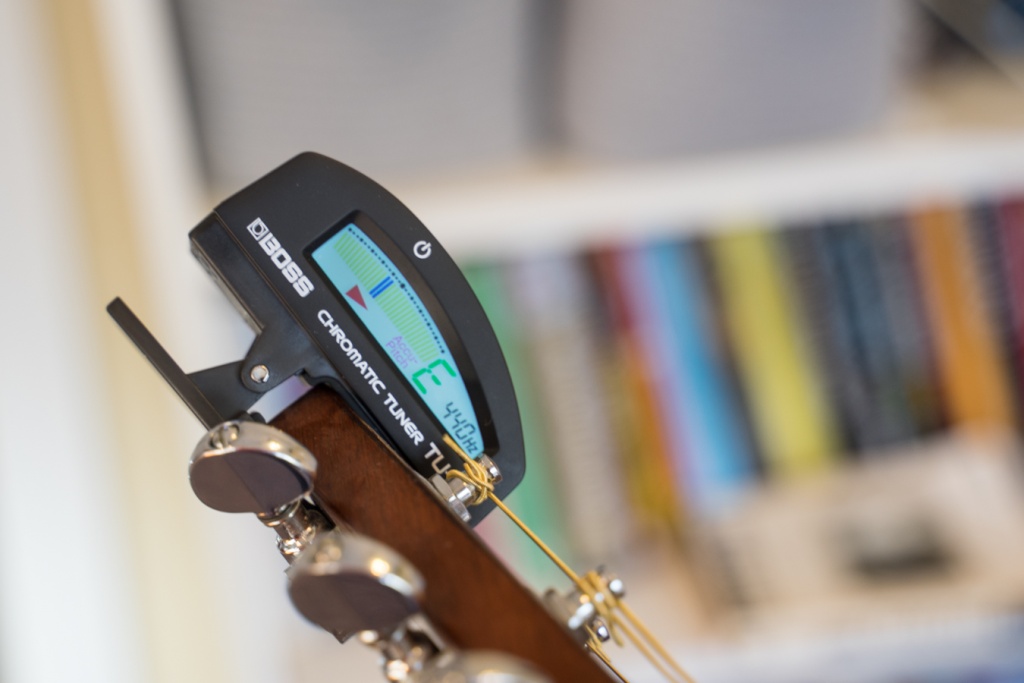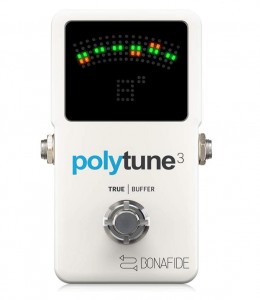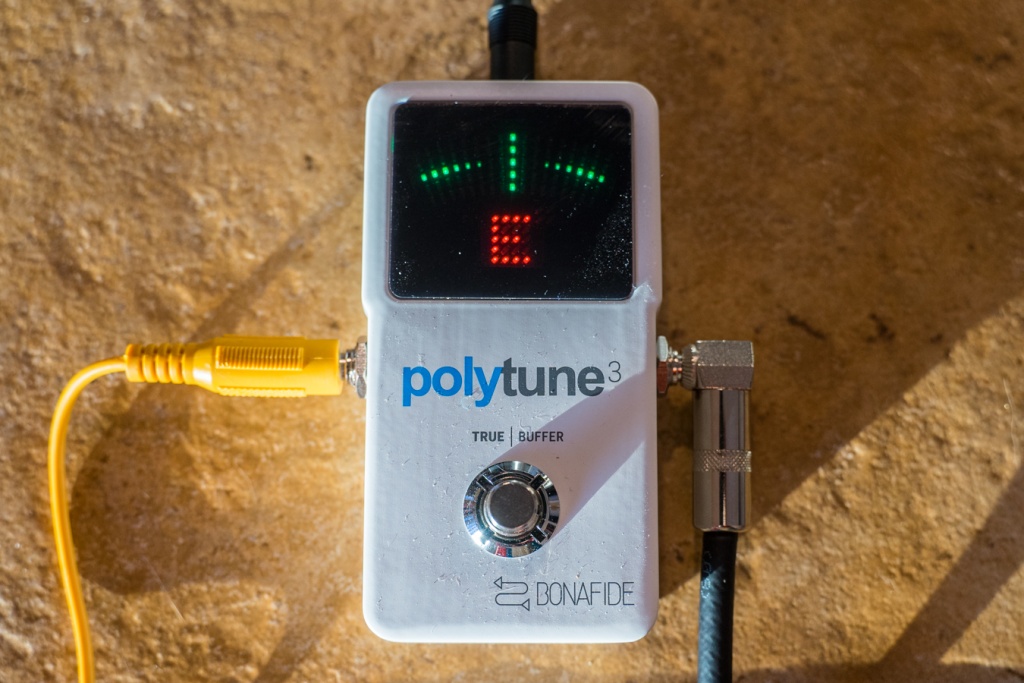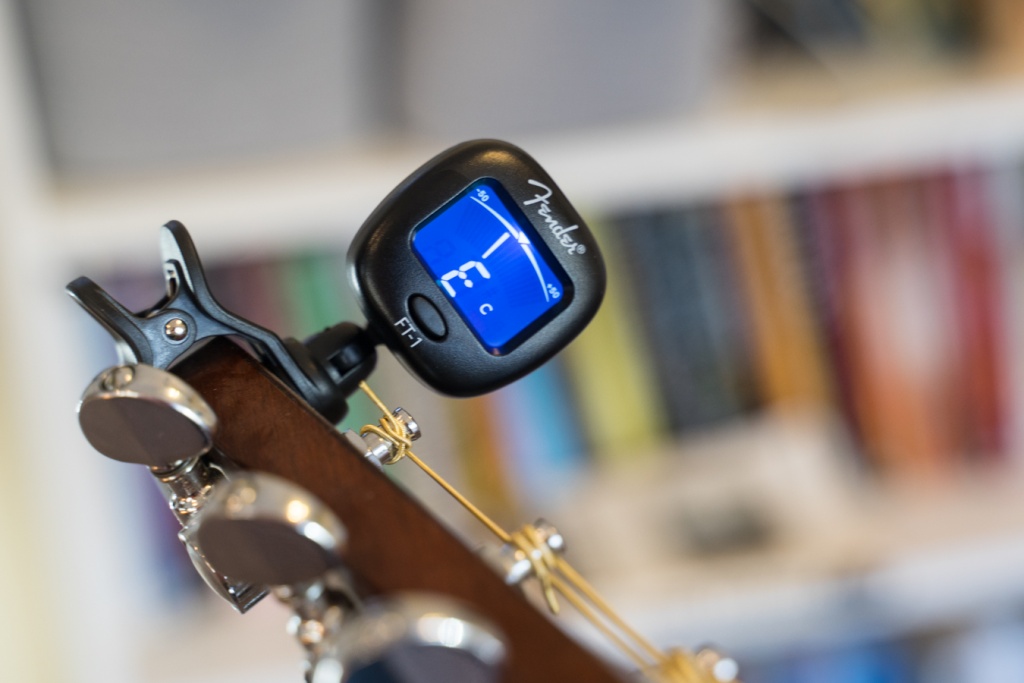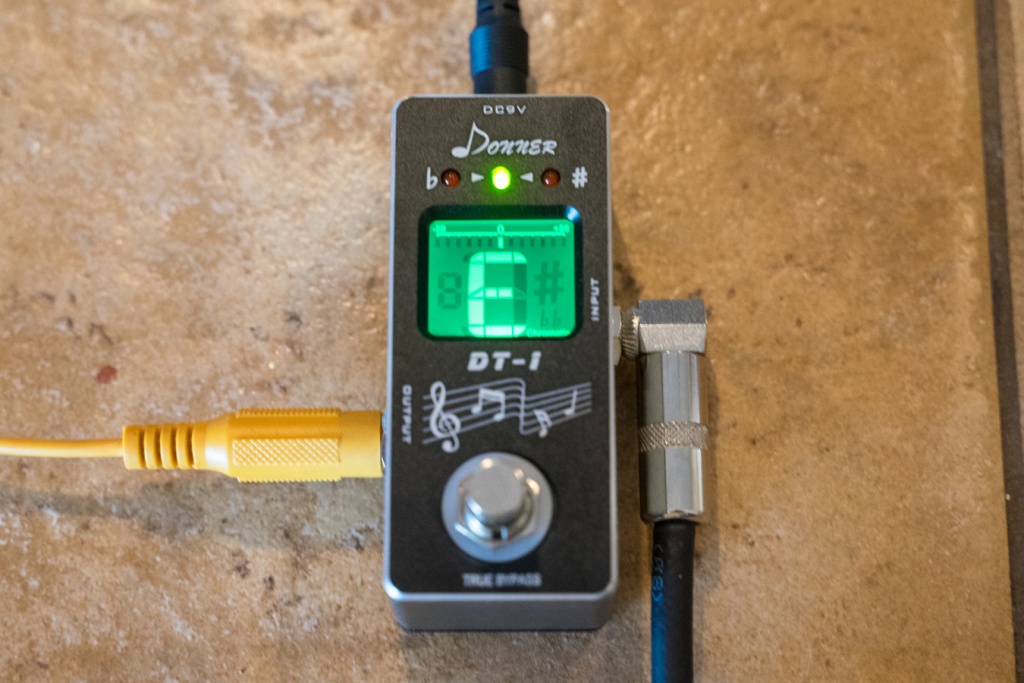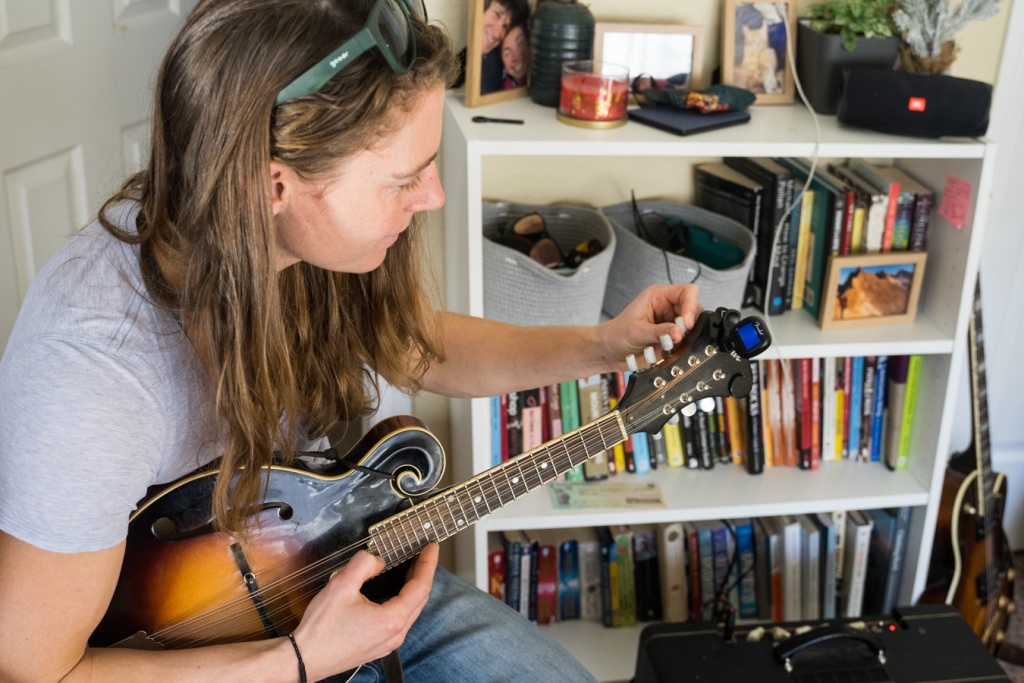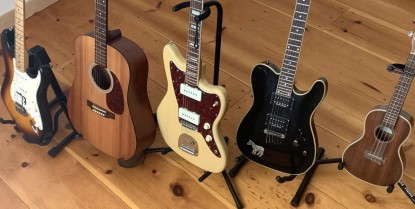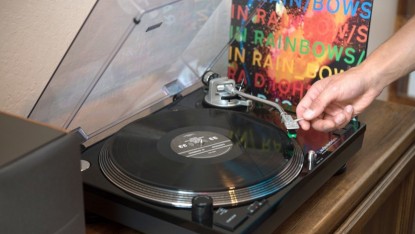Our resident guitar slingers purchased 9 of the top-rated guitar tuners available today to test head to head to discover the best clip-on and pedal tuners for you, whether you're playing in your living room or in front of thousands of adoring fans. We used each model to tune acoustic guitars, electric guitars, and finicky mandolins and ukuleles while subjecting them all to a barrage of tests. We even tried tuning while playing monotonous drone tracks as they assessed each model for interference issues. We tuned with a stopwatch to learn which tuners are the fastest tool for the ultimate roadie. Our conclusions will point you down the road to the right guitar tuner for you.
Whether you're just starting out with your first guitar or ukulele, or searching for a guitar stand for your growing collection, we can offer expert advice to help you find the best products to enhance your musicianship. We've also tested the best audio equipment on the market, including USB microphones, if you're ready to start recording your own songs at home.The 5 Best Guitar Tuners
| Awards | |||||
|---|---|---|---|---|---|
| Price | $99 List $78.94 at Amazon | $50 List $41.25 at Amazon | $37 List $30.80 at Amazon | $25 List $10.95 at Amazon | $80 List |
Overall Score  |
|||||
| Star Rating | |||||
| Pros | Quickly identifies untuned strings, optional strobe display, modes for alternate tunings and capo, USB connection enables firmware updates | Super fast, tunes wind instruments, includes metronome, tone generator | 3 display modes, ability to tune 5 semitones below standard, well-lit display, battery conserving setting | Fast, easy to read, 5 tuning modes, works in noisy situations | 4 display modes, heavy-duty construction, simple to read |
| Cons | Expensive | No line out, no DC power option | Larger than many clip-on options | No strobe option, only calibrated to 440 Hz | No alternate tuning presets |
| Bottom Line | This tuner will get you in tune fast and offers loads of customizable features | An excellent practice tool that combines a highly accurate tuner and a metronome | An excellent all-around model, chock full of useful features despite its size | A compact little tuner that is simple for beginners and accurate for pros | This solid pedal tuner is ready to keep you in tune, gig after gig |
| Rating Categories | TC Electronics Poly... | Korg TM-60 | BOSS TU-10 | Fender FT-1 | Korg Pitchblack Adv... |
| Accuracy (25%) | |||||
| Speed (25%) | |||||
| Display (25%) | |||||
| Features (25%) | |||||
| Specs | TC Electronics Poly... | Korg TM-60 | BOSS TU-10 | Fender FT-1 | Korg Pitchblack Adv... |
| Type | Pedal | Handheld/clip-on | Clip-on | Clip-on | Pedal |
| Calibration range | 440 Hz | 410-480 Hz | 436-445 Hz | 440 Hz | 436-445 Hz |
| Time to tune | 0:46 | 0:57 | 1:02 | 0:59 | 1:01 |
| Time to tune with interference loop | 0:55 | 1:02 | 1:32 | 1:41 | 1:15 |
Best Overall Clip-on Guitar Tuner
BOSS TU-10
For professionals and experienced musicians, the BOSS TU-10 is a fast and precise chromatic tuner that offers a few unique and useful features not found on other models. For starters, there are three display modes. In the "Acupitch" display mode (our favorite), the indicators flow towards the center of the display when your string is getting in tune. With Acupitch off, the indicator simply lights up to the left or right of the center to show whether the note is sharp or flat. There is also a display mode where the screen flows left to indicate the note is flat and right to indicate it's sharp, slowing down when the note gets closer to the correct pitch, similar to a strobe tuner. We found this mode especially useful when tuning a mandolin, which has doubled strings and is more difficult to precisely tune than a guitar.
Unlike more petite models, the TU-10 has a large display that can make the whole thing feel a bit clunky. It's large enough that it made our ukulele feel off-balanced when clipped to the headstock. This guitar tuner doesn't have a swivel mount like the other tuners we tested, though we're hard-pressed to imagine a scenario where a swivel mount is essential to view the display. Thanks to its speed, accuracy, and "strobe-like" display mode, our testers believe this is the best clip-on tuner for professionals. For better speed and accuracy than this, you'll need to be plugged into a pedal tuner.
Best Pedal Tuner
TC Electronics PolyTune 3
TC Electronic is well known for its innovative, feature-laden effects pedals, so we weren't surprised to find their take on the pedal tuner is awesome, effective, and easy to use. First and foremost is the feature that gives TC Electronics PolyTune 3 its name. The PolyTune feature allows the player to simultaneously strum all the open strings on their electric guitar and quickly identify which strings are out of tune through an intuitive display. Then the display automatically switches to present whatever string you're trying to tune. This feature is incredibly useful for the working guitar player. With this tuner pedal, you can quickly cut the signal to your amp and ensure your guitar is perfectly in tune. As with most of the pedals in TC Electronic's line-up, the PolyTune is teeming with useful features. The pedal can be set to tune a guitar or bass or used as a chromatic tuner. You can also change the display setting from simple arrow indicators to a dynamic strobe display. This pedal is durable enough for the rowdiest gigs, easy to read down on the floor, and has true bypass, so it won't affect your signal when turned off. Alternatively, you can change it to a buffered setting that splits the signal from your guitar so you can reference the tuner while still hearing your guitar through the amplifier. For better or worse, the buffer will slightly change the signal from your guitar, and how it sounds with the buffer is completely subjective.
Other than the price, there isn't much to complain about when it comes to the PolyTune 3. The model we received includes a setting for DADGAD tuning, one of the more popular alternative tunings, and we'd love to be able to add settings for different open tunings. The micro USB port on the side of the pedal for firmware updates leads us to believe that other customizable settings are a possibility, much like the toneprint features in TC Electonic's other popular effects pedals. Whether you play in a worship band, at weddings, or in front of thousands, the PolyTune is a great way to keep your electric guitar in tune while you keep the tunes coming.
Best Bang for Your Buck
Fender FT-1
The Fender FT-1 is a fast, accurate clip-on tuner for music students and professionals. Our testers were skeptical of this tuner, assuming it would be a basic device with the Fender logo slapped on for easy sales. However, we were pleasantly surprised as this guitar tuner performed at the top of its class. It did well under noisy conditions and has one of the most easily read displays of any clip-on tuner we tested. The FT-1 has five tuning modes: chromatic, guitar, bass, violin, and ukulele. While an experienced musician can get by using only the chromatic mode, less experienced players will enjoy the instrument-specific modes, as they display the note and the string number being tuned. This reinforces the association between note and string names for the aspiring musician and can make tuning quicker and easier. This little tuner stayed locked onto the notes from an acoustic guitar while we played a loop of loud droning notes through an amplifier. The tuner could hear the notes even when we couldn't, making the FT-1 a solid choice for acoustic jams in a room with multiple instruments.
This tuner can only be calibrated to 440 HZ, the most commonly recognized "Concert A" or the A above middle C on a piano. Most of the competition allows for a limited range of calibration to other frequencies, and many orchestras tune to 441 or 442. Since the overwhelming majority of working guitar players are playing in bands, at church, or in contemporary sessions that tune to 440, we don't consider the FT-1's lack of calibration range to be much of a limiting factor. Players who swear by strobe tuners need not apply, as this model doesn't have a strobe display. For everyone else, this clip-on tuner is a solid and affordable choice.
A Great Budget Pedal Tuner
Donner DT-1 Chromatic
The Donner DT-1 is an affordable pedal tuner with true bypass and an excellent display. To top it off, this is the most compact tuner pedal we tested, so it won't take up too much real estate on your pedalboard, saving space (and cash) for that Strymond Bigsky you've been eyeing for so long. While this guitar tuner doesn't have a strobe display or special settings for alternate tunings, it will cut your signal to the amp and get your instrument in tune without subjecting your adoring fans to the monotonous drone of EADGBE again.
Of all the pedal tuners we tested, the DT-1 is the slowest to lock on to a note. While it only takes a few seconds (even faster if you mute the other strings with your fingers and use the 12th fret harmonic), it isn't jaw-droppingly quick like similar offerings from KORG and TC Electronic. The DT-1 can only be calibrated to 440 Hz, but this isn't an issue for the average guitar player. At such an affordable price, there is no excuse not to have a pedal tuner in your effects chain.
An Awesome Practice Tool
Korg TM-60
The KORG TM-60 is a fast and responsive guitar tuner that works with a variety of instruments and even vocals, making it perfect for ear training. The metronome feature can improve your timing, and will accommodate any time signature, too. For guitar players, this tuner's speed lets you work on your intonation while bending or playing slide, and it's also excellent for practicing non-fretted instruments like cello or violin. The TM-60 uses a built-in microphone to analyze sounds but also includes a clip-on microphone that senses vibration. When using the clip-on sensor, this tuner is lightning fast.
For the working musician in dark or noisy settings, this model is not a good choice. It easily locks on to other loud tones in the room. While it has a line in for an electric guitar, there is no line out, so it can't be incorporated into an effects chain. The display is small, and while it's easy to read on a desk or music stand in front of you, it's hard to see while standing a few feet away. However, it's perfect for the practice setting and could be an excellent tool for students and music teachers.
Compare Products
Why You Should Trust Us
Today's technology makes playing in tune easier than ever. Various apps can even turn your phone into a crude guitar tuner, but for many applications, they fall short. Tuning apps are unreliable in noisy environments, impossible to read on stage, and slow to register sounds. We spent hours pursuing top musical instrument websites to determine the best-selling, highest-quality tuners. We bought the top models for various uses, including models that clip onto the guitar's headstock, sit at the front of an effects chain, and tuners that rest on your desk or music stand. After receiving an impressive line-up of tuners, we created four metrics for evaluation: accuracy, display, speed, and features. For each metric, we devised a series of tests that separate the tuners that are "close enough for rock and roll" from the solid, reliable models that perform to the standards needed by real working musicians.
We strive for critical, side-by-side product comparisons from folks who are both experts and enthusiasts. For our guitar tuner review, we look to Matt Bento to design and implement the bulk of our testing. A guitar player of 25 years, Matt brings his demanding ears and penchant for sonic perfection to evaluate these tuners from a variety of perspectives. The needs of recording artists, garage rockers, church players, and barroom musicians differ slightly, but everyone needs to be in tune. Having inhabited all of these roles, Matt is endowed to give these tuners a proper evaluation not only to determine the best tuner, but also the best model for your specific needs.
Analysis and Test Results
As testing began, we had three testers with different experience levels sit down with various stringed instruments (one acoustic guitar, two electric guitars, a mandolin, and a ukulele, to be exact). What followed was a maddening chorus of tuning, de-tuning and drones of 440 Hz blaring through speakers. We plugged and unplugged cables, mashed buttons, and squinted at displays. After this cacophony, we can confidently proclaim which tuner is the best for each application.
Value
Though it doesn't play into our review scoring, value is always an important consideration. Why purchase a low-priced product if it isn't going to perform? In our tuner review, the Fender FT-1 stands out for its great speed and accuracy and a low price tag. The Korg TM-60 is another with a high price-to-performance ratio. It was one of the best performers of the bunch and one of the most accurate and fastest tuners we tested. If you're willing to shell out a little bit more for a quality product with useful features, the Boss TU-10 is one of our favorites.
Accuracy
For accuracy, we first established a baseline by calibrating each tuner to 440 Hz "Concert A" and sending a 440 Hz signal to the tuners. For the clip-on tuners, we simply put them next to a speaker and blasted the tone. For the pedal tuners, we played the tone and held it to the guitar's pickups. All the tuners passed this test, correctly registering "A" in under a second.
The tuners distinguished themselves in our practical testing when we tuned actual guitars. We tuned each instrument using the 12th fret harmonic to minimize overtones that might throw the tuners off. The Boss TU-10 always registered the correct note on its display, and the Fender FT-1 also showed a high degree of accuracy, displaying the correct string number when we used it in its specific tuning mode. The venerable KORG TM-60 also nails it, especially when using the clip-on vibration sensor/microphone. We could sing into the KORG and get an accurate reading. The D'Addario Micro Tuner picked up overtones and would occasionally display the wrong note. The Snark ST-8 Super Tight also occasionally displayed overtones (a B when we were tuning the E string, for example). Among the pedal tuners, the TC Electronic PolyTune 3 is very accurate, especially when using the PolyTune feature, but the other two tuner pedals are very close behind, and none of the tuner pedals had accuracy issues.
The real accuracy testing came when we simulated a noisy practice environment. We played a loop of droning notes, chords, clicks, and squelches, then tuned up our trusty Martin D-35 acoustic guitar using each tuner. The loop was loud enough that our testers couldn't hear the strings on the Martin over the loop, so they had to rely only on the information coming from the tuners' displays. The Pedal tuners read the signal coming from the electric guitar's pickups and thus are impervious to outside noise. The clip-on tuners all use vibration sensors to detect the note's pitch, but they are susceptible to interference from sounds powerful enough to vibrate an acoustic guitar, like our drone loop.
Surprisingly, one of the least expensive tuners, the Fender FT-1 was least affected by our drone loop, followed by the Boss TU-10. The Snark ST-8 occasionally displayed an overtone, but we still managed to get the guitar in tune in under two minutes without actually being able to hear the guitar. Without employing the clip-on sensor feature, the KORG TM-60's mic picked up the loudest sound in the room and could not tune the guitar, but with the sensor, it is fast and accurate. Curiously, the D'Addario NS Micro Sound Hole had the most difficulty discerning the notes from our loop and the guitar we were trying to tune. We believe this is because it connects to the sound hole, a part of the guitar that vibrates more than the headstock, and our loop track played loud enough that we could feel the body of the guitar vibrating from the notes playing on the loop.
Speed
For this metric, we considered how quickly the guitar tuners registered the correct note, how much the indicator arrows danced around before displaying clearly that a note was "in-tune," and timed the overall process to tune six out-of-tune strings. The TC Electronic PolyTune 3 dominates the speed metric. After a little practice and an adjustment of the settings, we were able to tune an electric guitar (without actually being able to hear it) in under 40 seconds. The strobe setting lets you easily see when the string was in tune, and the "PolyTune" feature allows you to quickly identify which strings are out of tune by strumming all six open strings at once. The KORG Pitchblack Advance is also admirably quick. It just lacks the PolyTune feature and a strobe display. The Donner DT-1 is the slowest of the pedal tuners, but only marginally. Its indicator lights are a bit more finicky than the other pedals, and it takes slightly longer to lock on to the notes, but the entire display lights up a prominent green when you get the note in tune.
The KORG TM-60 is lightning fast when you use the clip-on sensor. Thanks to its speed and its large display screen that shows precisely how flat or sharp the note is, it makes an excellent tool for practicing intonation on fretless instruments like a violin or when practicing slide guitar.
Among the clip-on tuners, the Boss TU-10 dominated (again) thanks to its Acupitch display, where the indicators dramatically flow to the center of the screen to indicate a note is in tune. Tuning with the Fender FT-1 is also a quick process (as long as you've set it to the correct type of instrument), as it registers notes quickly, the entire display lights up green when the string is in tune. It even displays the string number you're playing, alleviating time-consuming confusion for beginner players. The Snark ST-8 gets the job done for our experienced players in just over a minute, while the D'Addario Micro Tuner reliably takes the longest, picking up overtones and initially displaying the incorrect notes on its small, dimly lit display.
Display
When comparing the displays, our main concern is how easy the display is to read, be it a clip-on tuner at the end of the guitar's headstock or a pedal tuner down on the floor. For the solo acoustic guitar player, whether jamming in the bedroom or singing songs of grief and introspection down at the coffee shop, the D'Addario NS Micro Sound Hole takes the cake. This tiny tuner fastened to the bottom of your guitar's soundhole, barely noticeable to anyone but the player. You merely need to play a note and look down below the 6th string to see the tiny display showing the note you're playing, with flat and sharp indicators on either side. The obvious limitation here is that this model can only clip to a soundhole, so you can't fix it to electric guitars, archtops, or any other stringed instrument without a big round soundhole.
The Boss TU-10 is the clip-on tuner that displays the most information with its wide display that shows a range of flat and sharp semitones, plus a strobe-like feature that lets you tune based on the speed of the moving indicators. Helpful for folks who may have trouble seeing certain colors, this tuner allows you to switch over to a black and white display.
The Snark ST-8 has the largest display of a single note, and is the easiest to read out of the headstock tuners in our test. Conversely, the D'Addario Micro Tuner's display is very small and somewhat dim. In bright lighting, it's difficult to see the flat and sharp indicators, and the notes appear very faint. The notes on the Fender FT-1 aren't giant, but the entire display lights up a bright green when the notes are in tune. The indicators that show which tuning setting it's on are tiny, and tuning an instrument on the wrong setting — for example, your guitar on the ukulele setting — could lead to some frustration.
The pedal tuners all have dazzling LED light-up displays. The most straightforward to read is the KORG Pitchblack Advance. It shows the notes in large block letters. The TC Electronic PolyTune 3 shows more information, but the notes are smaller. The Donner DT-1 features a backlit digital display, and while it isn't our favorite, we had no trouble discerning what notes were displayed or whether they were sharp or flat. It's worth noting that of the three-pedal tuners, the PolyTune 3 is the only one that has a buffer setting. This means that it can be set to split your guitar's signal so that you can tune your guitar (or see what note you are playing) while still hearing it through the amplifier. The Donner and KORG pedals only have true bypass settings, which means they won't affect your guitar's signal while they're turned off, but when you hit the switch to tune-up, you won't be able to hear any sound coming through your amp.
Features
We evaluated the features of each pedal to determine if they are useful additions or cumbersome fluff. We also consider any standout traits of each model. The Boss TU-10 is the most feature-laden of the clip-on tuners, with three display modes and a calibration range from 436 to 445 Hz. It also has the option to lower your tuning down to five semitones, which is very convenient for guitar players using thick strings and need to tune down, or if you want to play in E flat and still use all your open string licks.
The Fender FT-1 has a neat feature that lets you tune a specific instrument (guitar, bass, violin, or ukelele) while it displays the string number along with the note, a very useful feature for beginners. It also has a chromatic setting, so you can still tune to any other note you'd like. The D'Addario Micro Tuner lets you change the display to orient it horizontally or vertically, but our testers didn't find this feature particularly appealing or useful. The same goes for the Snark ST-8's included metronome. The metronome is a flashing heart icon, not an audible tone, so for it to keep time, you need to be staring at the tuner, with your attention away from your hands or sheet music.
The KORG TM-60 has an awesome metronome that uses audible beeps and a little chirp on the one count, with buttons to change time signatures and tempo. It also has a tone generator that generates three full 12-tone octaves. This is great for ear training and working on your intonation while playing any instrument. To top things off, the TM-60 includes a clip-on vibration sensor you can plug into the tuner and attach it to your guitar, your sitar, or even your trumpet for fine-tuning. While this unit is not the best choice for performance environments, it is an excellent tool for students and teachers alike.
The TC Electronic PolyTune 3 is perfect for playing gigs when you need to get an unwieldy guitar in tune quickly. You can click it on and cut the signal to your amp, strum all the strings at once, and immediately see which strings are sharp or flat. It takes a few tries to get oriented to the display, but once our testers figured it out, they preferred this pedal tuner over the others, as the whole tuning process is very quick and easy. The PolyTune 3 also has multiple display modes, a drop D setting, and a micro-USB port for firmware updates. The KORG Pitchblack Advance has a few display settings that let you change how the indicator lights display sharps and flats. The Donner DT-1 has no display settings or special features, but it does have an affordable price and is quite functional, although we would hesitate to use it in a professional setting.
Conclusion
We thoroughly enjoyed evaluating these guitar tuners, and while some are quicker and easier to use and read than others, each does an adequate job of helping you get your guitar in tune. You are better off with any of these tuners than without any tuner at all. Your friends and family will thank you for always playing in tune, and a good tuner is mandatory when playing with others unless you are blessed with perfect pitch. We believe our detailed tuner review will help you choose the best model for your needs, whether you're playing on stage or your back porch.
— Matt Bento


